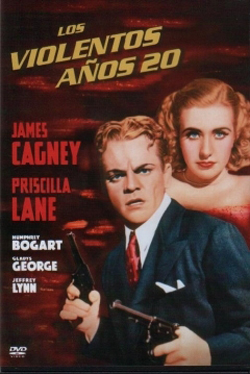Titulo original: The Roaring Twenties
Año: 1939
País: EE.UU.
Duración: 104 min.
Dirección: Raoul Walsh
Guión: Jerry Wald, Richard Macaulay y Robert Rossen, basado del periodista Mark Hellinger.
Música:
Heinz Roemheld
Temas musicales: “I´m Just Wild About Harry”, interpretado por Priscilla Lane at the club; “My Melancholy Baby”, interpretado por Priscilla Lane on the train, at the audition, and at the club; “It Had to Be You”, interpretado por Priscilla Lane at the club; “In a Shanty in Old Shanty Town”, interpretado por Gladys George at Flanagan´s; “Mademoiselle from Armentières; “Beside A Babbling Brook”; “I´m Forever Blowing Bubbles”; “Swanee”; “Beside A Babbling Brook”; “Carolina in the Morning”; “Ain´t We Got Fun”; “The Japanese Sandman”; “Bye Bye Blackbird”; “Tip Toe Through the Tulips with Me”, interpretado por George tips off Nick Brown; “If I Could Be with You”; “Cryin for the Carolines”; “Smiles”; “Sweet Georgia Brown”; y “Dancing with Tears in My Eyes”.
Intérpretes
James Cagney, Priscilla Lane, Humphrey Bogart, Gladys George, Jeffrey Lynn, Frank McHugh, Paul Kelly, Elisabeth Risdon, Edward Keane, Joe Sawyer, Joseph Crehan, George Meeker, John Hamilton, Robert Elliott, Eddy Chandler, Abner Biberman, Vera Lewis, Eddie Acuff, Ernie Alexander, Murray Alper, Robert Armstrong, Raymond Bailey, Brooks Benedict, James Blaine, Max Blum, Wade Boteler, Harry C. Bradley, Al Bridge, Paul Bryar, Nat Carr, Glen Cavender, Clay Clement, Ann Codee, James Conaty, Ray Cooke, Calvin Coolidge, Charles Corrigan, Maurice Costello, Kernan Cripps, Alan Davis, Sayre Dearing, Joe Devlin, Robert Dobson, Bill Elliott, James Flavin, Bess Flower, Curt Furburg, Fred Graham, Creighton Hale, Bert Hanlon, Carl Harbaugh, Sam Harris, John Harron, Eddie Hart, Lew Harvey, Oscar WDutch” Hendrian, Al Herman, Herbert Heywood, Al Hill, Harry Hollingsworth, Stuart Holmes, George Humbert, Lloyd Ingraham, Michael Jeffers, Jane Jones, Mel Kalish, Don Thaddeus Kerr, Donald Kerr, Milton Kibbee, Reid Kilpatrick, Mike Lally, Alfred Linder, George Lloyd, Arthur Loft, Charles Marsh, Frank Mayo, King Mojave, Philip Morris, Jack Mower, Wendell Niles, Field Norton, Jack Norton, Wedgwood Nowell, Pat O´Malley, Oscar O´Shea, David Oliver, Emory Parnell, William Pawley, Lee Phelps, Paul Phillips, John J. Richardson, John Ridgely, Cyril Ring, Warren Rock, Don Rowan, Hector V. Sarno, Cliff Saum, Jeffrey Sayre, Bruce Sidney, John St. Clair, Amzie Strickland, Charles Sullivan, Elliott Sullivan, George Tobias, Westbrook Van Voorhis, Max Wagner, Billy Wayne, Ben Welden, Dick Wessel, Leo White, Frank Wilcox, Lottie Williams, Norman Willis y Charles C. Wilson.
Sinopsis
Estados Unidos, Ley Seca, años 20. Después de la Primera Guerra Mundial, la readaptación a la vida civil de muchos soldados norteamericanos se hace extremadamente difícil por el gran paro y la crisis económica existente en el país. La casualidad hace que tres neoyorquinos, destinados en Europa durante la Primera Guerra Mundial, se conozcan al buscar refugio en el mismo agujero dejado por un obús. siguen diferentes caminos. Cuando regresan a América tras luchar por su país, tropiezan con el problema del desempleo y con grandes dificultades económicas. Uno de ellos llamado Lloyd Hart (Jeffrey Lynn) seguirá con decisión el buen camino; otro, Eddie Bartlett (James Cagney), amargado por la falta de futuro, no encuentra más salida que el contrabando ilegal de alcohol durante los años de la Ley Seca; el tercero George Hally (Humphrey Bogart) se convierte en un implacable gángster.
Comentario
Raoul Walsh se basó en un artículo periodístico para mostrar tres diferentes caminos en la reinserción en la sociedad civil de tres veteranos que habían luchado por su país en la Primera Guerra Mundial. Fundamentalmente narra la ascensión y caída del gánster Eddie Bartlett (interpretado por James Cagney), dedicado al contrabando de licor en la época de la Ley Seca. Se desarrolla en un espacio de tiempo muy amplio, el que media entre el final de la Primera Guerra Mundial (1918) y el crack de Wall Street (1929), y la posterior elección presidencial de Franklin Delano Roosevelt (1932). Para cubrir este lapso temporal, el director recurre a menudo al resumen mediante hábiles efectos de montaje, utilizando en ocasiones material de archivo grabado en la época. Este hecho, unido a la utilización de titulares de periódico y a la voz en off que va comentando la historia y explicando los hitos fundamentales en la historia de la prohibición, confiere a la película un tono cercano al del documental.















